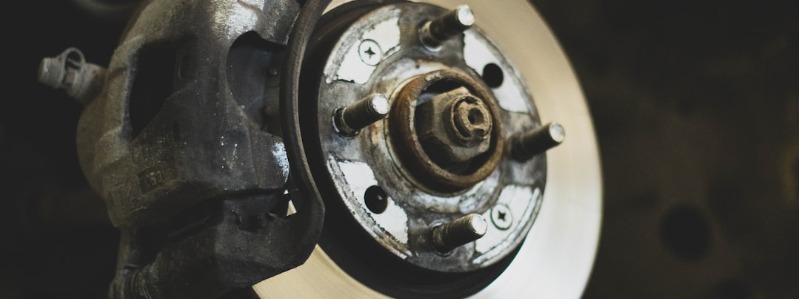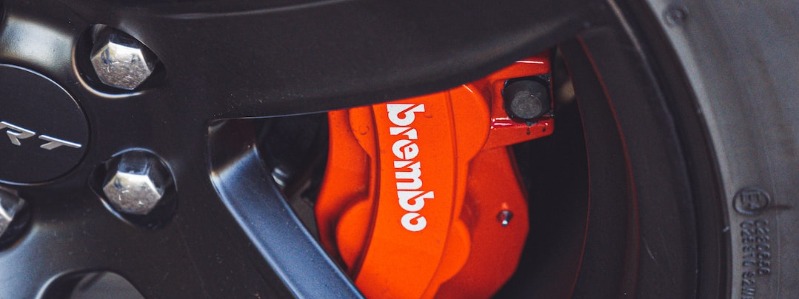When to Change Your Brake Pads
Contents
Knowing how your vehicle responds in certain situations is key to keeping it serviced so you are driving as safely as possible. One big safety issue that drivers should be aware of and keep maintained is the brakes. How often should you change brake pads? How do you know when the brake rotors need to be replaced? Do calipers ever need to be replaced? Your auto mechanic will be happy to answer your questions about brakes.
By understanding how brakes work, you will understand how important keeping them in good condition is. Here is a brief explanation of how brakes work in simple terms. Applying the brake pedal causes a chain reaction—the calipers cause the brake pads to clamp down on the brake rotors. This pressure on the rotors prevents them from spinning, thus stopping your car.
So how often should you change brake pads? The typical mileage interval for replacing brake rotors or brake pads is about every 70,0000 miles. Of course, the following factors play a big role in how long your brakes last:
- Style of driving—fast accelerations and hard braking, riding the brake pedal, drive consistently in mountainous terrain.
- Weight of vehicle—driver, plus passengers, plus cargo.
- Quality of the brake components—don’t use the cheapest, but stick to mainline good quality parts.
- Use of vehicle—towing, transporting heavy objects, or commuting long distances.
Signs it’s time to change your brake pads
It’s crucial to keep your brakes in good condition to ensure safety on the road. However, how do you know when to change your brake pads? Here are some signs to watch out for:

- Squeaking or squealing sound: If you hear a high-pitched noise when applying the brakes, your brake pads are worn out. The sound is produced by a built-in wear indicator that lets the driver know it’s time to change the pads.
- Reduced responsiveness: Worn-out brake pads will reduce the responsiveness of your vehicle’s brakes. You may notice that it takes longer to stop your car or that the brake pedal feels softer than usual.
- Vibration or pulsation: If you feel a pulsating or vibrating sensation when you apply your brakes, it could be a sign that your brake pads are worn out or damaged. This could also be a sign of warped rotors, so it’s best to have your brakes checked by a professional mechanic.
- Visual inspection: You can visually inspect your brake pads to see if they need to be replaced. If the pads are less than 1/4 inch thick, it’s time to change them. Also, if you notice any unusual wear patterns on the pads, such as uneven wear, it could be a sign of a bigger issue with your brakes.
If you’re noticing stopping problems, watch out for these signs:
- Screeching or squealing sounds – A small, metallic shim indicator is embedded in the brake pad to indicate when it has worn too thin.
- Pads that are too thin – Brake pads should be no less than ¼ inch thick (about 3 millimeters) in depth.
- Metallic grinding and growling – The brake pads have worn down, resulting in metal-on-metal contact between the discs and calipers.
- Dash warning light – Newer vehicles have a warning light on the instrument panel, indicating it’s time to replace the brake pads.
Remember: Replace both the brake rotors and the brake pads at the same time for even stopping performance.
Types of brake pads
When it comes to changing brake pads, there are different types to consider. The type of brake pad you choose is important because it will affect the performance of your braking system and the longevity of your brake pads. Here are the most common types of brake pads:
Ceramic Brake Pads
These are made from ceramic fibers and nonferrous filler materials. They are known for being quiet and producing less dust than other types of brake pads. They are also more expensive than other types of brake pads.
Organic Brake Pads
These are made from organic materials such as rubber, glass, and resin. They are softer and produce less noise than other types of brake pads. They are also less expensive than other types of brake pads.
Metallic Brake Pads
These are made from iron, copper, and other metallic materials. They are durable and provide good stopping power. However, they produce more noise and dust than other types of brake pads.
Semi-Metallic Brake Pads
These are a combination of metallic and organic materials. They offer good stopping power and are more durable than organic brake pads. However, they produce more noise and dust than ceramic brake pads.
Checking your brake pads visually
Checking your brake pads visually is crucial in determining whether they need to be changed. It only takes a few minutes and can save you much money in the long run. You can look at the brake pads through the wheel spokes.
Check the thickness of the brake pads. They must be replaced immediately if they are less than 1/4 inch thick. Secondly, check for signs of wear on the brake pads. If they have deep grooves or are unevenly worn, then it’s time to change them.
Another visual check is to look for strange brake pad colors. If they are blue or black, this could indicate that the brake pads are overheating and need to be replaced.
Different types of brake pads have varying wear and tear rates. For example, ceramic brake pads last longer than metallic brake pads. Therefore, it’s important to check your car’s manual to determine the type of brake pads your car has and the recommended replacement intervals.
Inspecting your brake pads by sound
One of the easiest ways to tell if your brake pads need replacing is by sound. When your brake pads wear down, they will start to produce a high-pitched squealing sound, similar to nails on a chalkboard. A small metal shim causes this sound called an indicator that is built into the brake pad. The indicator is designed to make a noise when the brake pad wears down to a certain level, warning you that it’s time to replace the brake pads.
It’s important to note that not all brake pads have indicators, so you should also be aware of any changes in the sound of your brakes as you apply them. If you hear a grinding or scraping noise, this could indicate that your brake pads have worn down completely and are now damaging the brake rotor, leading to more expensive repairs.
Another thing to listen for is a clicking noise when you apply the brakes. This can indicate that the brake pads are loose and need to be replaced or reinstalled properly.
Measuring brake pad thickness
Measuring brake pad thickness is crucial in determining when it’s time to change them. Brake pads come with a certain thickness, and as they wear down, they become thinner. The minimum thickness that a brake pad should have is usually specified by the manufacturer, and it’s important to replace them before they get too thin.
A brake pad thickness gauge is a handy tool that can measure the thickness of the brake pads. This tool has a scale that measures the thickness of the brake pads in millimeters. By inserting the gauge between the brake pad and the rotor, you can get an accurate measurement of the brake pad thickness.
Another way to measure brake pad thickness is by visual inspection. Looking through the wheel spokes, you can see the brake pad and estimate its thickness. If the pad appears to be less than a quarter inch thick, it’s time to replace them.
It’s important to note that different types of brake pads have different thickness recommendations, so always refer to the manufacturer’s specifications. Ignoring the thickness of your brake pads can lead to poor braking performance, and in extreme cases, it can cause your brakes to fail.
Don’t wait until it’s too late; check your brake pads periodically and replace them when necessary. Your safety and the safety of others on the road depend on it.
How to replace your brake pads
Replacing brake pads is important to maintaining your vehicle’s safety and performance. Before you begin, make sure you have the proper tools, including a wrench, pliers, and a C-clamp. It’s also important to have a replacement brake pad set that is the correct fit for your vehicle.
To start the process, first locate the brake caliper and remove the pins or bolts that hold it in place. Carefully remove the brake pads from the caliper and inspect them for wear. If they are significantly worn or damaged, it’s time to replace them.
Before installing the new pads, it’s a good idea to clean the caliper and rotor with a brake cleaner to remove any debris or dust that may have accumulated. Next, insert the new pads into the caliper and reattach the pins or bolts to secure them.
It’s important to note that if you’re only replacing the pads on one wheel, replacing the pads on the opposite wheel is a good idea to ensure even wear and performance.
Use a C-clamp to compress the caliper piston back into its housing, being careful not to damage the piston or brake line. Once the piston is fully compressed, reattach the caliper to the wheel assembly and test the brakes before driving.
If you’re unsure about the process or don’t feel comfortable doing it yourself, it’s always a good idea to consult a professional mechanic for assistance.
Brake Repair Quiz: What is your score?
Because brakes are your vehicle’s most critical safety system, it is important that you follow all maintenance and brake repair recommendations. This will help ensure that you operate your vehicle as safely as possible with fully functioning brakes. This is especially important while traveling on winter’s wet and icy roads. Unfortunately, some drivers don’t think much about the performance of their brakes until they notice stopping problems. Before heading down the road, you want to be confident that your vehicle will come to a complete and precise stop as needed.
Here is a simple quiz that will help you determine the condition of your brakes—good or bad. Take a short drive and pay attention to how your brakes perform when you apply pressure on the brake pedal, and then answer the questions below:
Do you keep traveling when you want to stop?
Your brakes may need an adjustment or possibly new linings.
Does your car pull to one side or the other when driving on a straight road?
A stuck caliper and fluid leak can cause this problem in vehicles with front discs.
Does the pedal pulsate when you step on it?
Your brakes may have overheated from overuse.
Does the steering wheel shake when you step on the brake pedal?
The front discs may need to be professionally machined or replaced.
Is there a squealing sound when you step on the brakes?
The linings may be worn and need to be replaced; the drum or disc may need to be machined; the front disc pads may be loose; the hardware that attaches to the calipers is worn; or the brake linings are of inferior quality.
Do you hear a grinding noise when stepping on the brake pedal?
Grinding brakes are caused by excessively worn linings, allowing the metal part of the pad or shoe to come in contact with the disc or drum. This can quickly ruin the most expensive mechanical parts of the brake system, the discs, and drums. Stop driving immediately and have your vehicle towed to an auto shop.
Does your vehicle bounce up and down when stopping?
The shock absorbers may need to be replaced.

